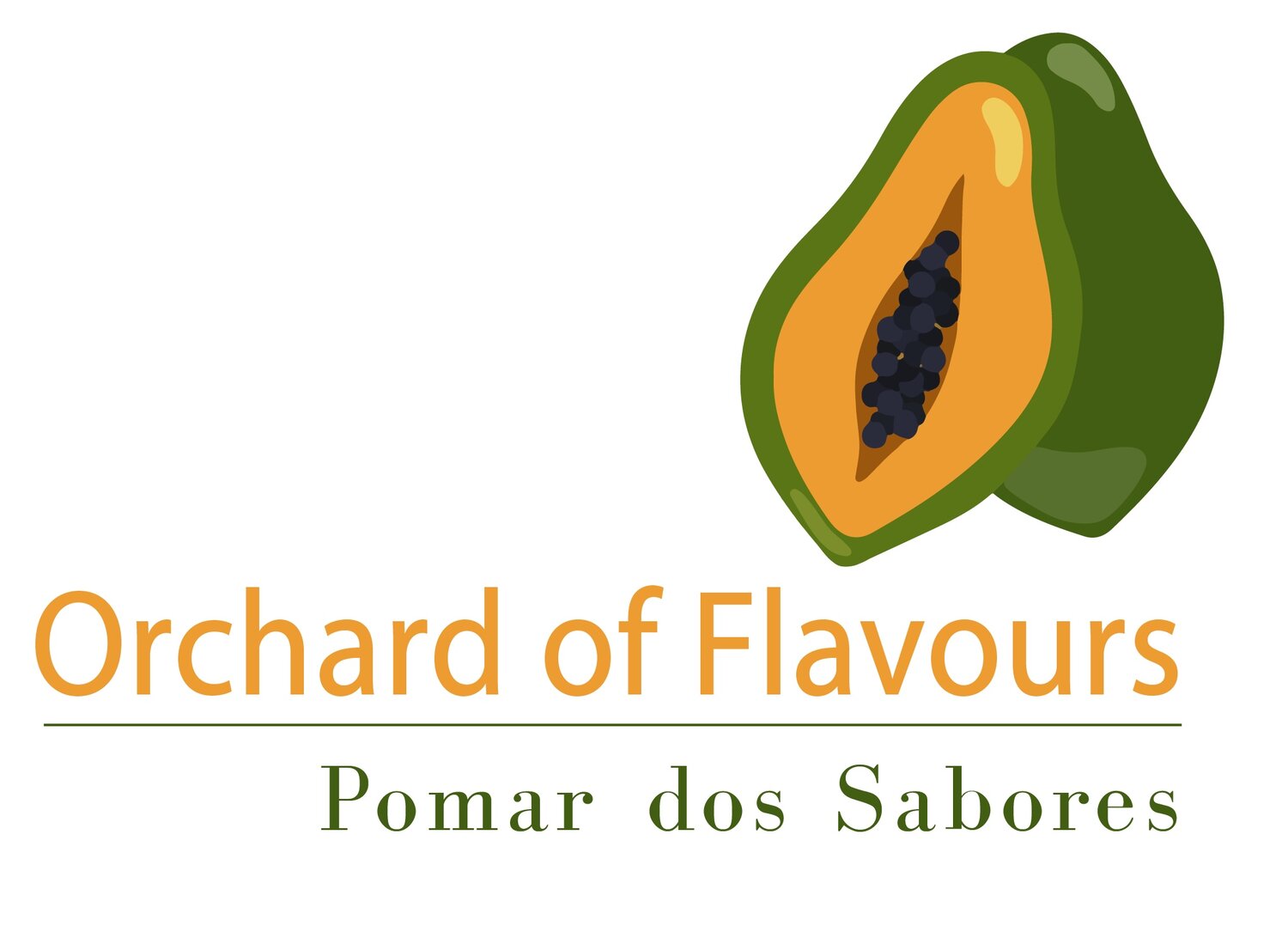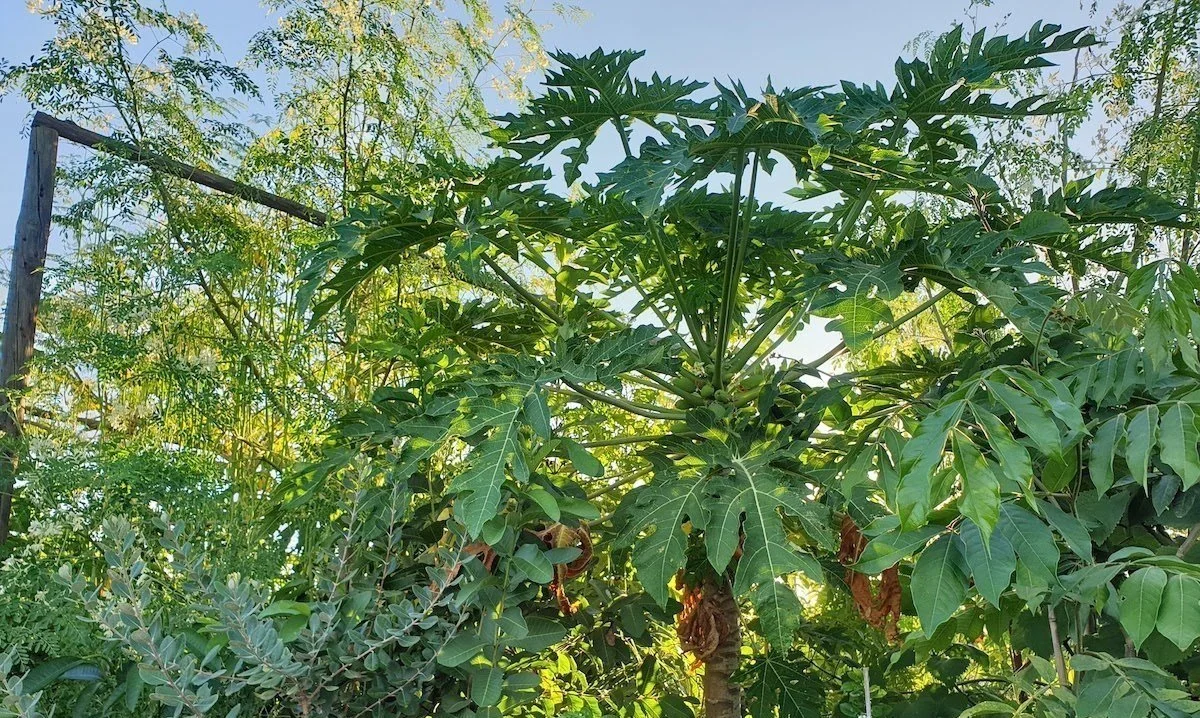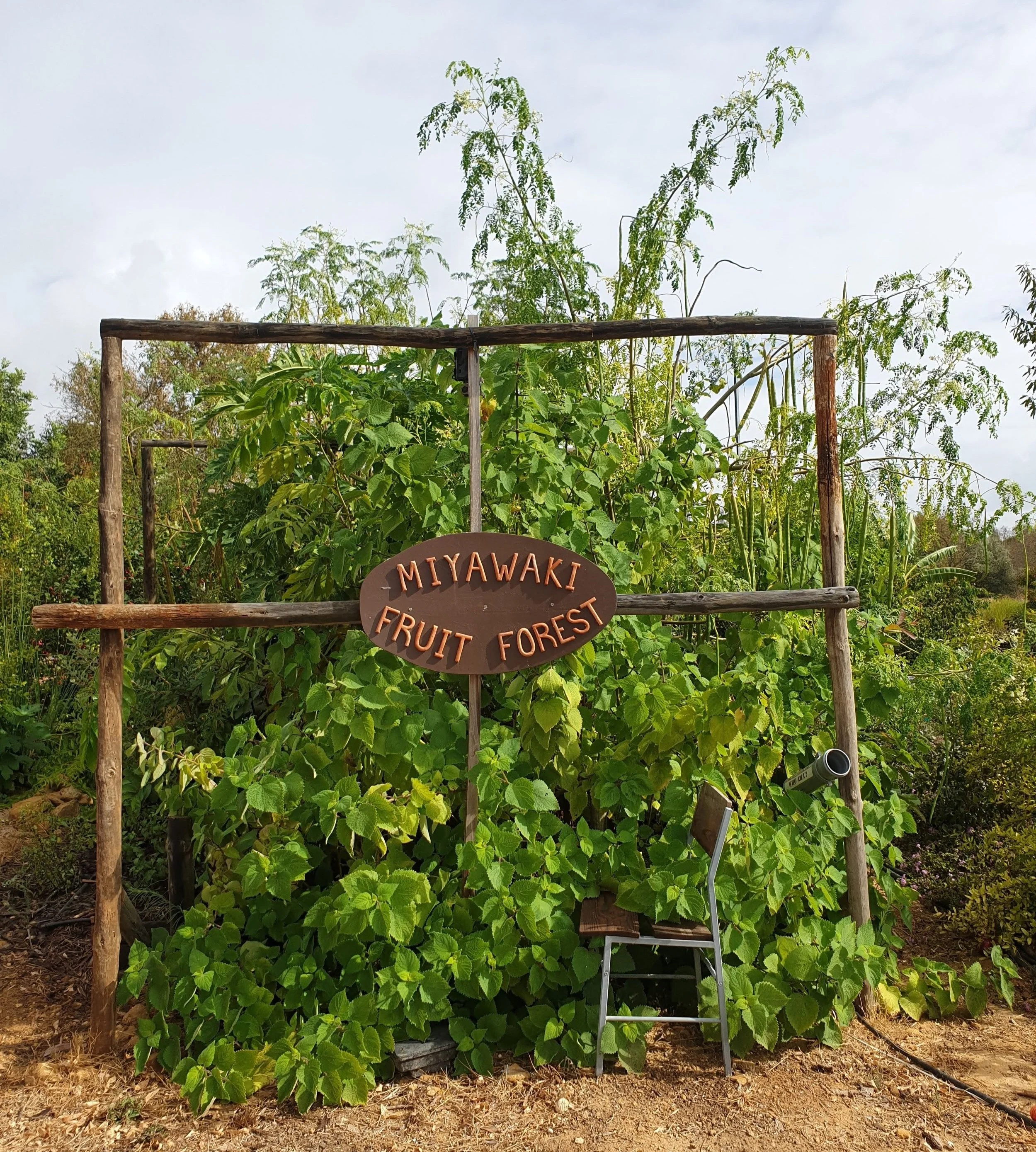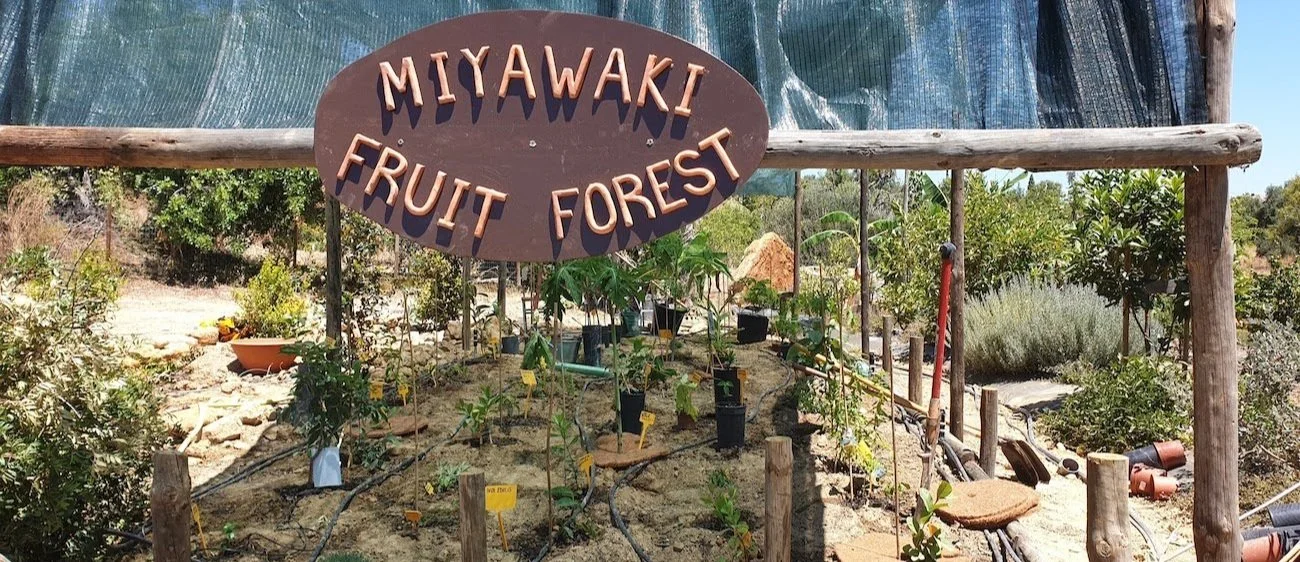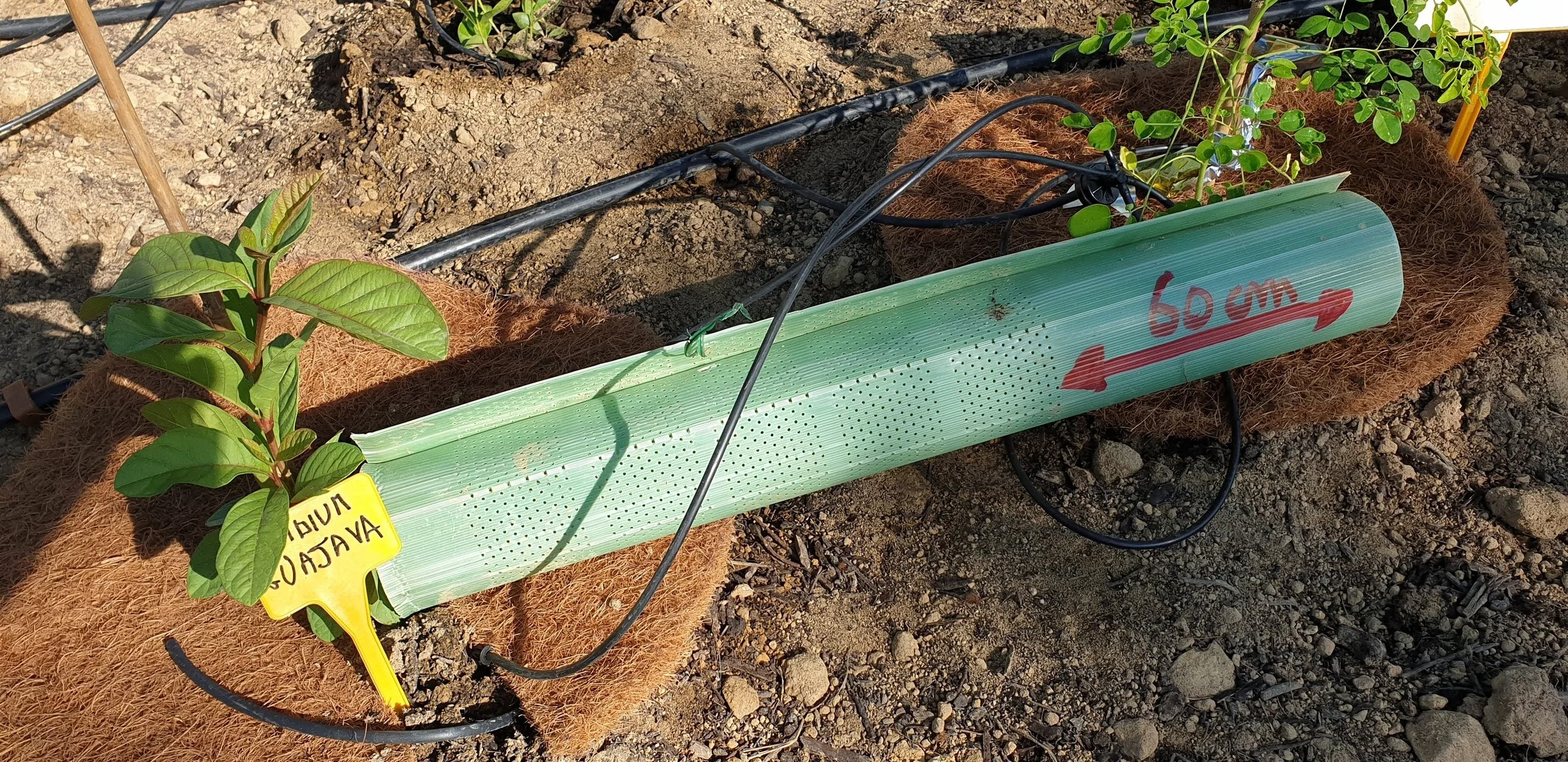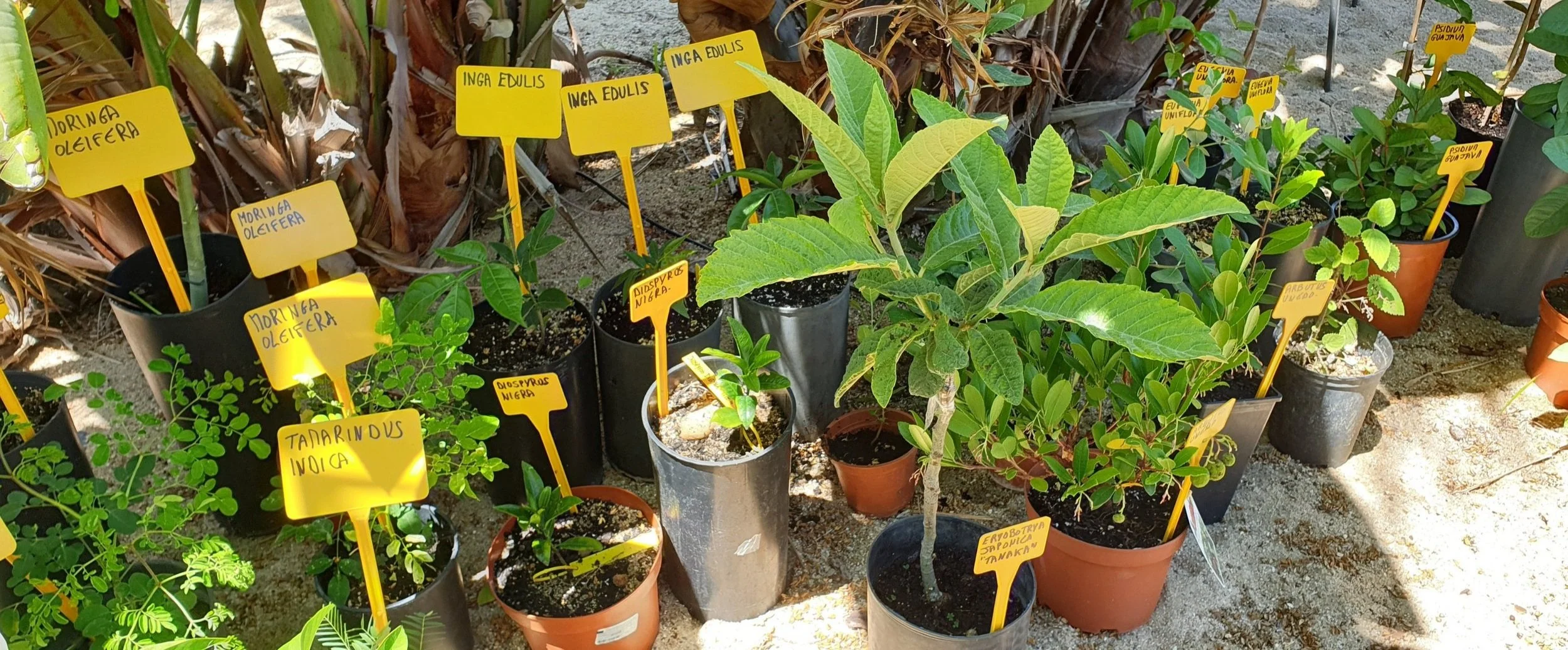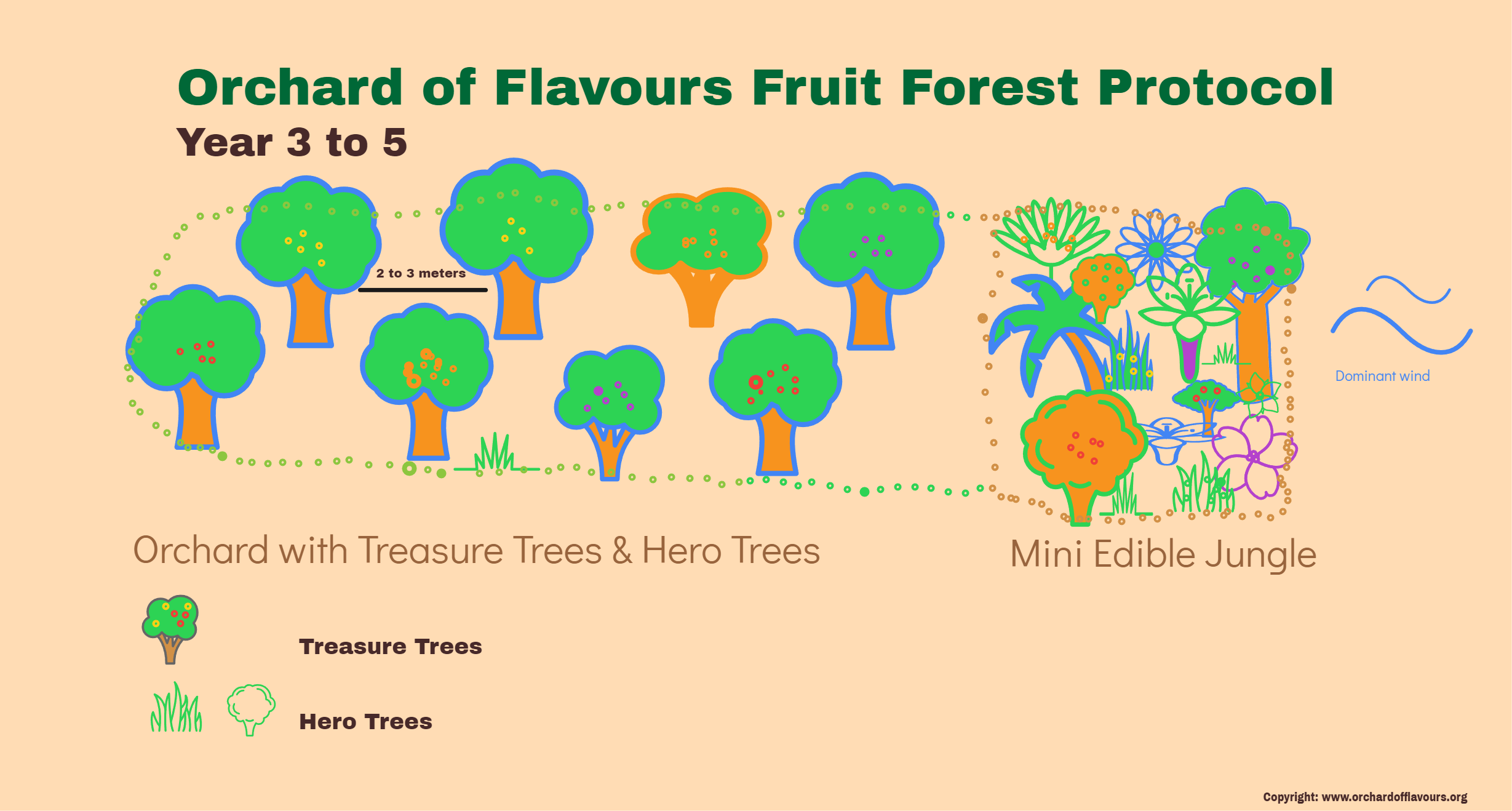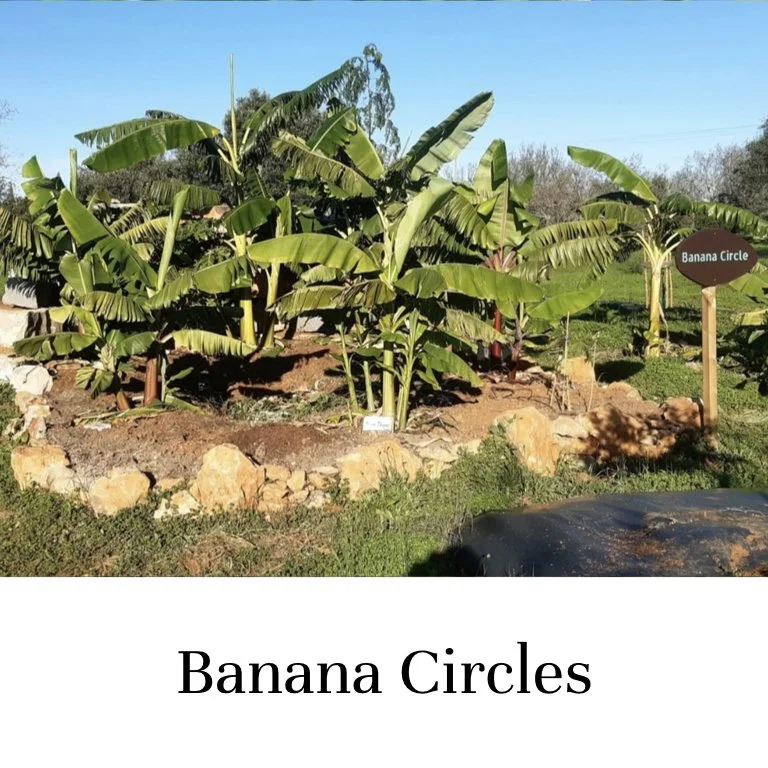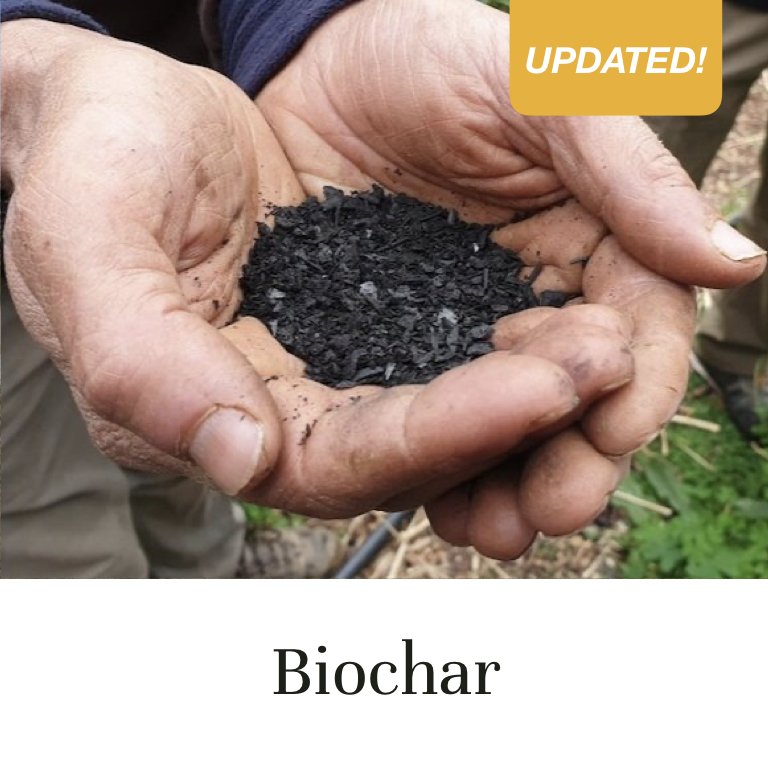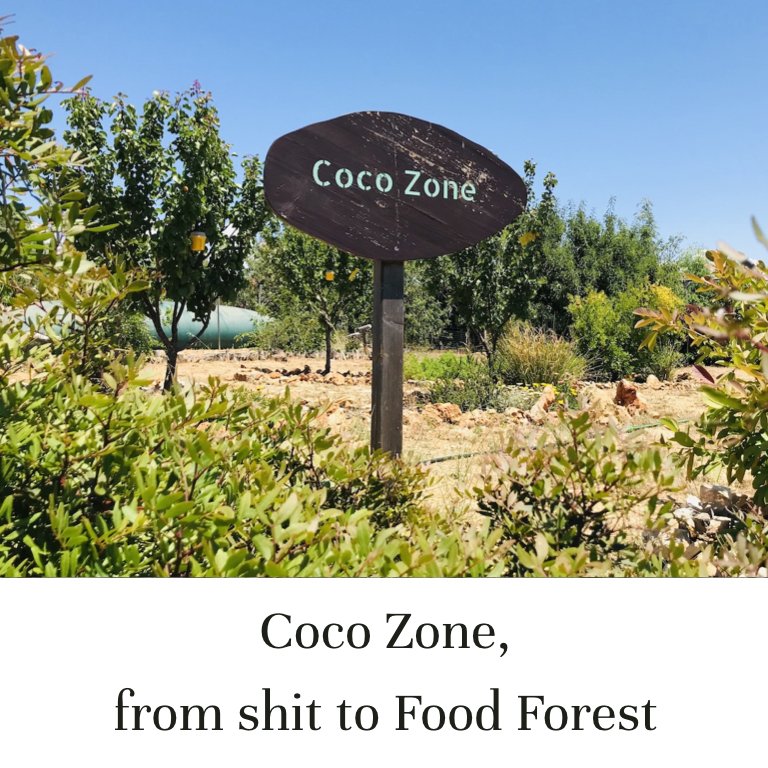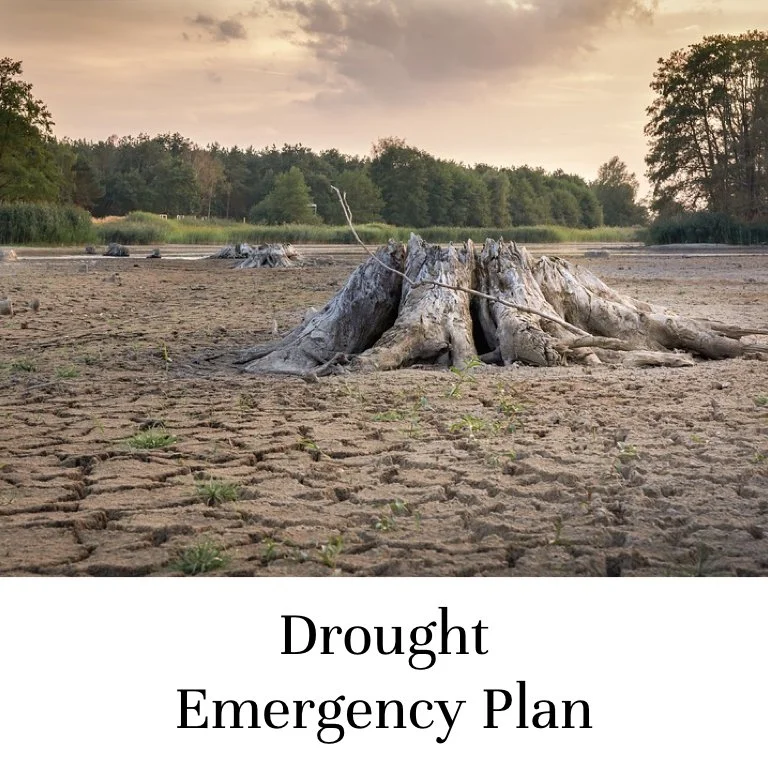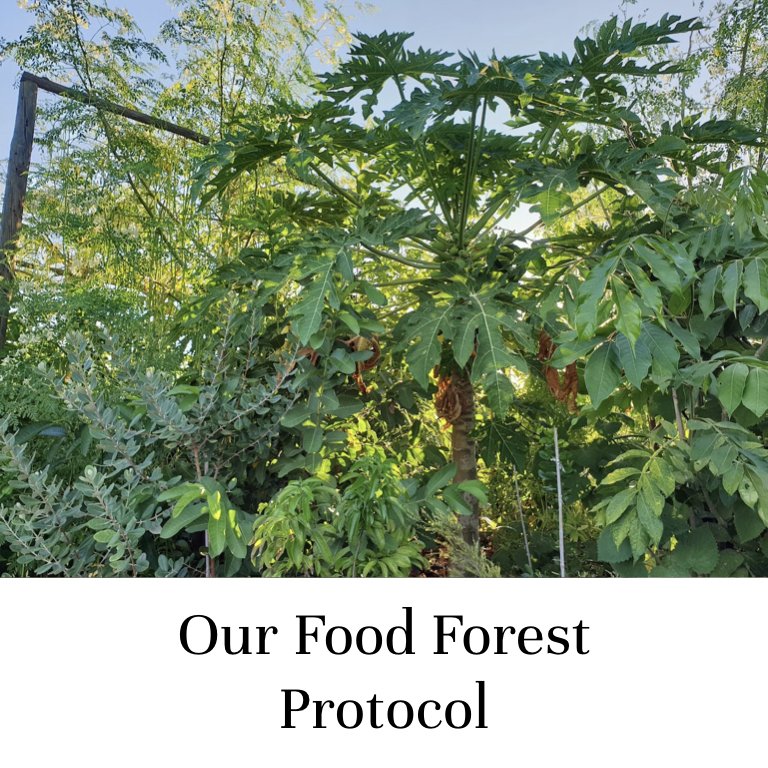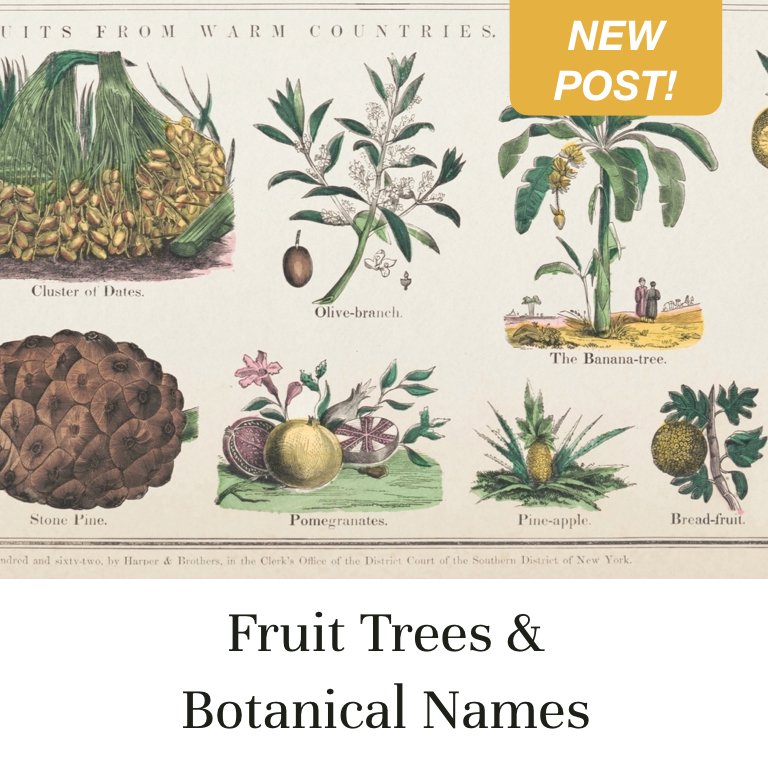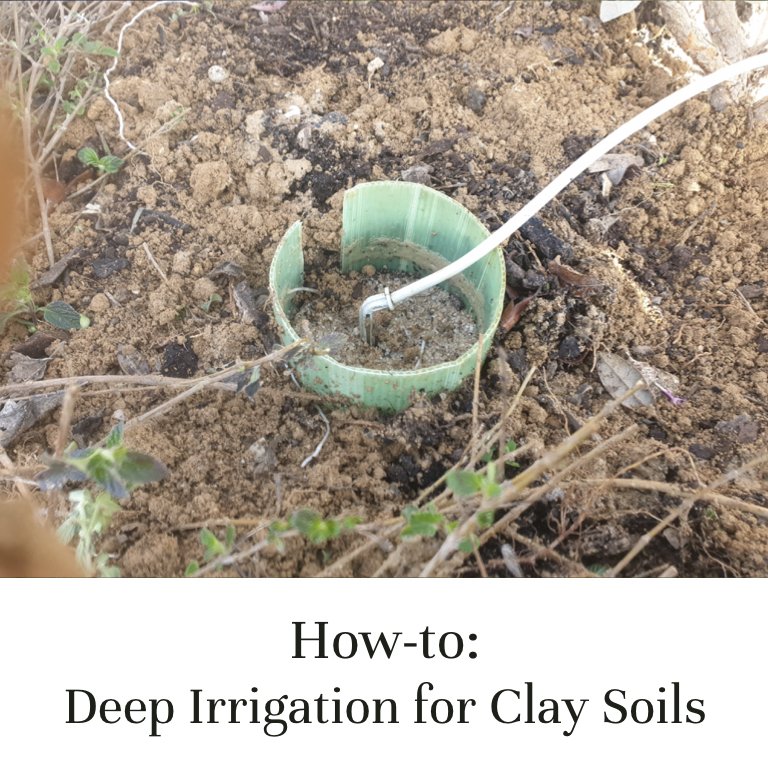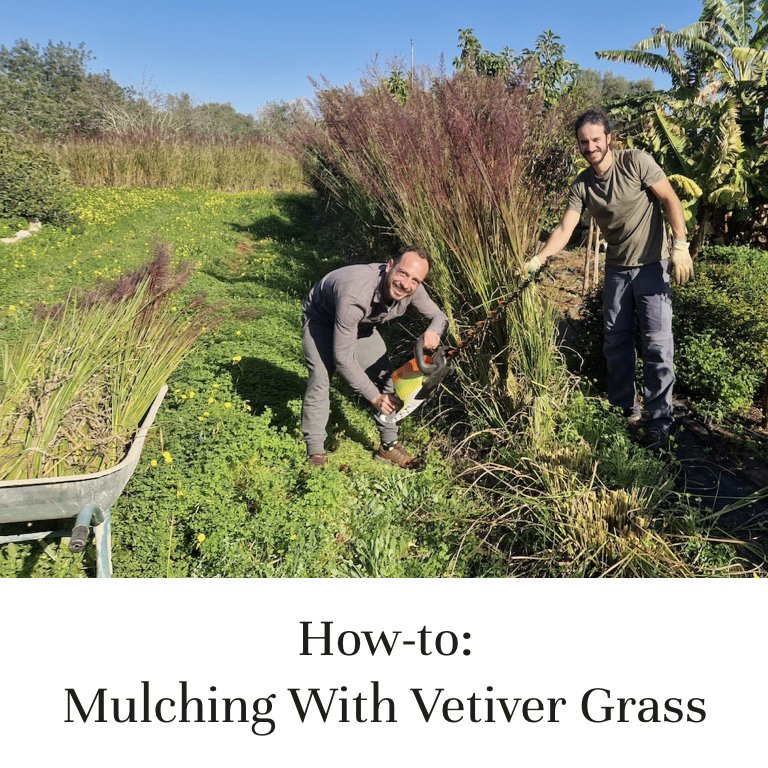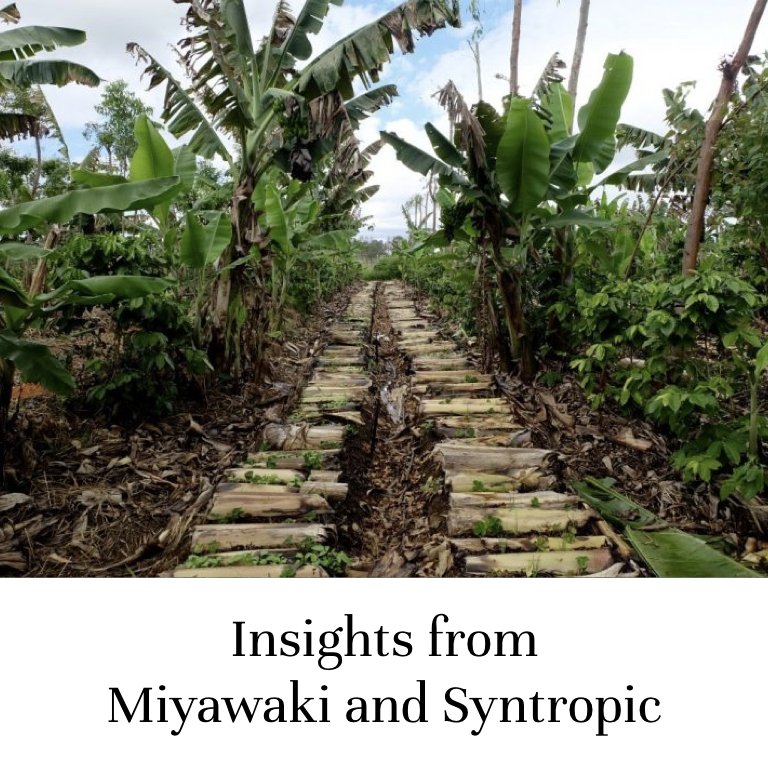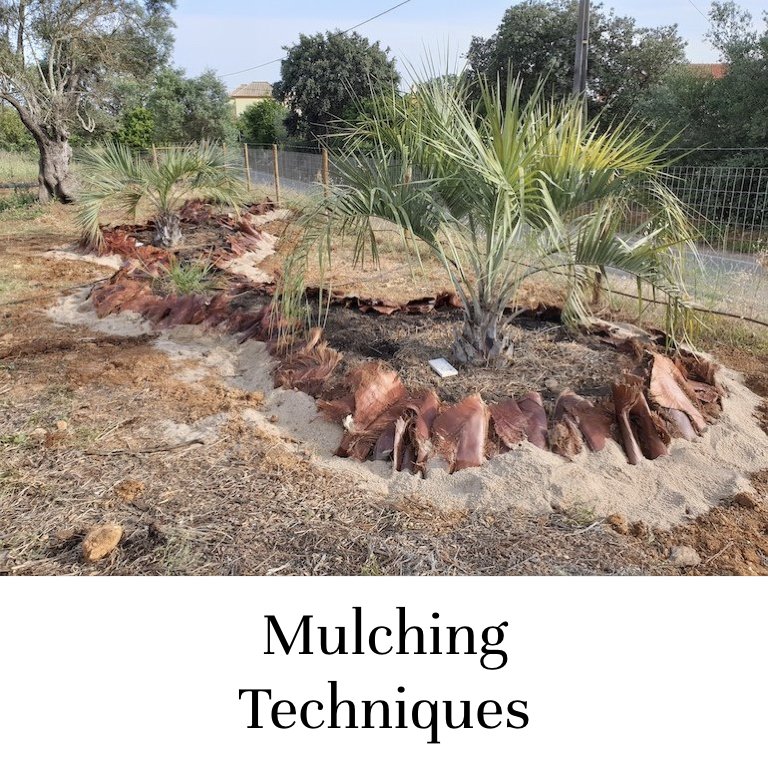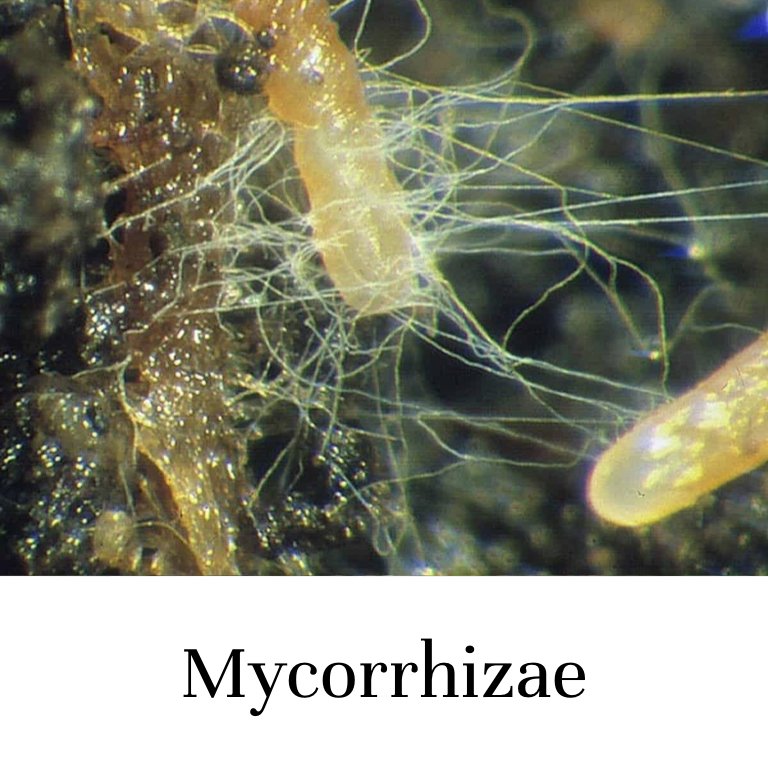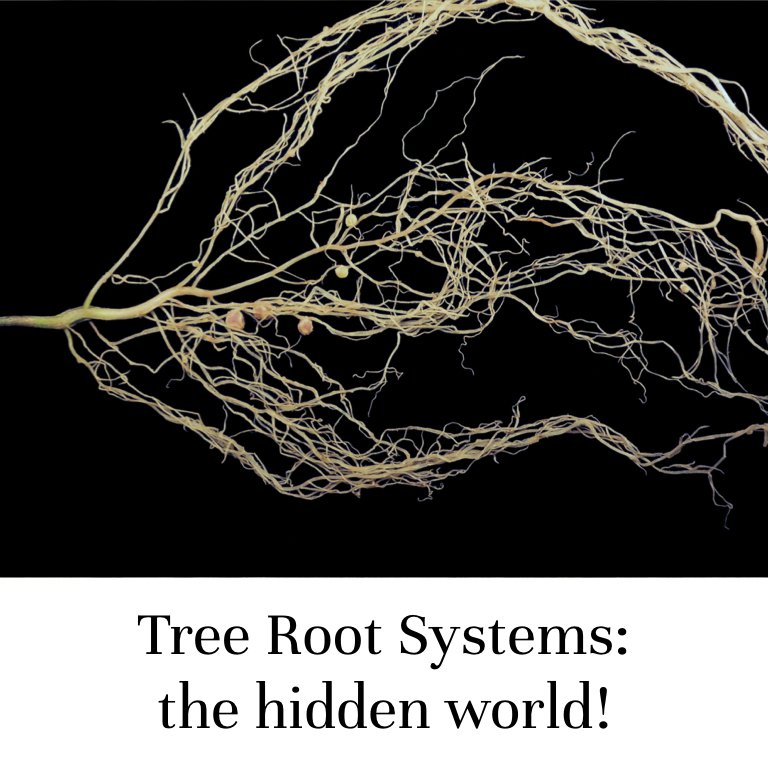The Orchard of Flavours
Food Forest Protocol
Our first Miyawaki-inspired Mini Edible Jungle, 1 year after planting.
Our goal with the writing of this article was to learn from some best practices of successional agroforestry and see if we could design a more rigorous and successful approach to the creation of a food forest in our environmental conditions. We also aimed to develop a clear, easy-to-apply protocol, limiting its scope to the production of fruit.
The context here at the Orchard is Southern Portugal, USDA Hardiness Zone 10a to 11a. This means that a large number of subtropical fruit trees can be planted here because of the mild winters. The coldest temperatures during the winter average around 7º Celsius with very rare hours at about 0ºC. The average yearly rainfall is only 500mm and irrigation water has to be used sparingly.
The first Mini Edible Jungle at the Orchard, 14 months after planting.
The Orchard of Flavours Food Forest Protocol is now being implemented systematically at the Botanical Garden. Our first Edible Jungle (a Miyawaki-inspired food forest) was planted in July 2021, and all the elements of the protocol used on that project are now being implemented on the one hectare extension of our garden, where we started working at the end of Spring 2022.
On our Insights from Miyawaki and Syntropic article, we made a review of the agroforestry approaches (Miyawaki Forest and Syntropic Farming) that have helped us create this new protocol of food forest. Reading it will help you better understand the rationale behind the proposed techniques.
Our Food Forest Protocol combines three main elements:
Mini Edible Jungles,
Treasure Fruit Trees
..which will be interplanted with Hero Fruit Trees.
We voluntarily chose non-technical words so that the protocol can be more easily understood, remembered, discussed and shared.
Mini Edible Jungles:
These dense food forests are inspired by the Miyawaki Mini Forests method.
They serve multiple functions, such as:
creating pockets of extreme biodiversity (providing habitat to beneficial fauna, like pollinators, predatory insects and diverse soil life)
serving as windbreaks for your nearby Treasure Trees (more on those in a bit)
providing shade to your nearby Treasure Trees
providing a yield (easy to harvest if you stick to Mini Jungles of about 10 square meters)
enabling you to grow certain very fragile fruit trees which would otherwise struggle. Many frost tender and fragile subtropical fruit trees will grow very well planted in this dense, protective environment (species such as papaya, certain varieties of annona, ginger or tamarillo).
The first Mini Edible Jungle at time of planting, in July 2021.
How to create your Mini Edible Jungle?
the idea is to boost the initial establishment process and give the trees the best growing conditions from the very beginning. The initial preparation is very intense: one-meter-deep decompaction with a bulldozer, around 2 tons of compost for 10 square meters, plus lots of composted horse manure.
plant a minimum area of 10 square meters. Miyawaki’s observations indicate that this is the minimum size to allow the biodiversity to develop enough. Don’t plant in lines but prefer a more compact zone.
Decompacting the soil and adding plenty of organic matter is key.
plant densely, 3 trees per square meter, that is a tree every 60cm. Plants will compete for light and will grow extremely fast.
always plant at the same time. This is essential to allow each tree to develop its root system.
when planting, add a cocktail of mycorrhizal fungi around the root system. This will help the roots get more nutrients and water. You can learn more about the benefits of this crucial symbiosis by reading our article on mycorrhizal fungi. We also discuss mycorrhizal fungi cocktails further in our biostimulants article.
select and plant many tree species in each Mini Jungle zone (min 30 species). Studies by the Japanese botanist Akira Miyawaki show that this is the minimum number of species necessary in order to create a pocket of extreme biodiversity.
incorporate a minimum of 3 layers (shrubs, mid-layer and canopy trees). This will help create a well-balanced forest while reducing the death rate of the trees.
Placing a tree every 60cm for a dense Edible Jungle.
plant the 3 layers randomly as in a Miyawaki Forest (not planned like in Syntropic Farming). However, if you want to use these little jungles to grow very fragile trees (for instance your frost-tender papaya), it makes sense to plant those in the center in order to maximise the protective effect.
mulch and weed systematically for the first three years, so as to maximise available water and nutrients.
as an option, you can take advantage of any existing Edible Jungles to grow vegetables or practice market gardening on the more protected side of your Mini Jungle. This will depend on your climate: In hotter regions like ours, certain varieties of vegetables can well benefit from the shade cast by the forest if we are to place them on the northern side.
Young trees waiting to be planted in one of our Mini Edible Jungles.
What fruit trees or edible plants should you choose for a Mini Edible Jungle?
at the end of this article, you will find a long list of the most drought tolerant fruit trees or other edible plants which are possible to grow in our climate. We insist on choosing drought tolerant species because water is becoming increasingly scarce and more than ever our food production systems and gardens must be able to face certain levels of drought.
Treasure Fruit Trees:
Your Treasure Fruit Trees are those you value the most for their crop and the ones which you want to keep for the long term.
We favour techniques that help our most valuable trees to grow fast and healthily, while remaining productive and resilient. In our protocol, Treasure Trees are planted at a reasonable distance of 2 to 3 meters from each other. This allows easy access and harvesting and is quite similar to commercial orchard practices. We recommend an initial intense soil preparation and adding lots of organic soil amendments in order to boost the levels of existing organic matter. At the Orchard, we are currently using two systems:
we either plant in very big holes (around 1 cubic meter decompacted by a bulldozer and addition of a minimum 210 liters of compost and 70 liters of horse manure compost);
or — and this is now our preferred method —, we first decompact and add compost and manure to the whole planting area. We add about 10 tons of compost and 5 tons of horse manure for every 100 square meters. This is more costly at the beginning but it enables us to plant wherever we want both our Treasure Trees and our Hero Trees (more on those in a bit). In these situations (at planting), we dig medium size holes (70cm by 70cm) and we just add 70 liters of plain compost and 35 liters of horse manure compost.
A diagram of our proposed protocol in action : on Year 1, a young Mini Edible Jungle grows to the east of the newly-planted orchard, where Treasure Trees are planted 2 to 3 meters apart, interplanted with Hero Trees, keeping a minimum of 1 meter distance between all trees or bushes.
When planting your Treasure Trees, you can take advantage of any existing Mini Edible Jungles. For instance, if your dominant wind comes from the east, you can plant any Treasure trees which are not wind-resistant (banana, papaya, macadamia, ...) on the west side of your Edible Jungle. You can also plant the trees which do not grow well in full sun to the north of an Edible Jungle. In Southern Portugal, most fruit trees, especially when they are young, will develop much faster if not in full sun.
Hero Trees:
We were inspired to use Hero Trees by the Syntropic Farming approach.
We call them “Hero Trees” because they play many important roles in the system:
they act as the protectors of your Treasure Trees during the initial growing phase, especially when the Hero Trees are fast-growing species. They can offer both sun and wind protection to your Treasure trees, as well as generally boosting diversity in the system.
later on, the Hero Trees will serve as “biomass trees”. This means that they will be systematically pruned or coppiced. The pruned materials will serve as mulch, allowing your soil to stay covered while these materials decompose. In addition, the action of pruning will also increase the biological activity happening on and in the soil, with the resulting cycling of nutrients contributing to improve soil structure, water retention capacity and the build-up of new humus. Pruning your Hero Trees will also have the effect of allowing more light to reach the establishing Treasure Trees, and let their root system develop further.
as fruit trees or edible plants, your chosen Hero Trees can bring you some yield as well. It might not be their first role, but this should not be neglected. Food production is now so crucial that we think it is good to find Hero Trees that can bring some valuable crops as well. And our research shows that it is quite possible to find such plants.
In our proposed protocol then, Hero Trees are interplanted with the Treasure Trees, and we recommend that a distance of minimum 1 meter should be kept between all trees or bushes.
A diagram of our proposed protocol in action : on Year 3 to 5, the fast-growing, and now more mature and lush Mini Edible Jungle helps shielding the orchard from the wind coming from the east. Having fulfilled their initial-phase duties as protectors, the Hero Trees are gradually pruned/coppiced or even removed from the system, allowing more space and sunlight for the Treasure Trees to grow.
After three to five years, you can clear or coppice a few Hero Trees to allow access and to facilitate harvesting your Treasure Trees, which by then will be more established and perhaps productive, depending on the species.
Selection criteria for choosing Hero Trees:
non-invasive root system
not propagating via the lateral roots
fast grower, preferably with a dense foliage — FG
bringing some edible yield (fruit trees or edible plants) — EY
supports heavy pruning or even coppicing — P / C / PC
drought tolerant — DT
high windbreak potential — WB
nitrogen-fixing ability is a bonus (it is rare but we can take advantage of this)
Lists of Hero Trees tested at Orchard of Flavours Botanical Garden (Southern Portugal):
Atriplex halimus (Mediterranean saltbush) — FG, EY, P, DT, WB
Bixa orellana (Achiote) — FG, ET, P, DT
Callistemon viminalis (Weeping bottlebrush) — EY, DT
Chrysopogon zizanioides (Vetiver) — FG, EY, PC, DT, WB
Cymbopogon (Lemongrass) — FG, EY, P, DT, WB
Moringa oleifera (Moringa) — FG, EY, PC, DT, WB
Muntingia calabura (Panama berry) — FG, EY, P, DT
Phyllanthus emblica (Indian gooseberry) — EY, C, DT, WB
Syzygium cumini (Java plum) — FG, EY, P, DT, WB
Syzygium paniculatum (Brush cherry) — FG, EY, P, DT, WB
Nitrogen-fixing Hero Trees:
Cajanus cajan (Pigeon pea) — FG, EY, P, DT, WB
Elaeagnus umbellata (Autumn olive) — EY, PC, DT, WB
Inga edulis (Ice-cream bean) — FG, EY, PC, DT, WB
Sesbania grandiflora (Vegetable hummingbird) — FG, EY, C, DT
Please note that this is an ongoing research and so this list is preliminary. We will be updating as we come across more relevant results in the future.
Feel free to contribute with your own ideas of what you find of our proposed protocol, as well as what species you find would be good additions to this approach :)
This article was written by Miguel COTTON, Jackson KNIGHTS & Miguel PEREIRA. If you have any questions or suggestions, do not hesitate to contact us. miguel@orchardofflavours.com
